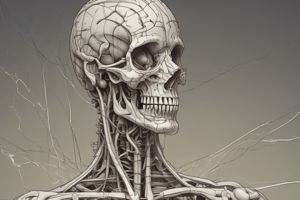Podcast
Questions and Answers
What is the primary action of the α1 adrenergic receptors in the sympathetic nervous system?
What is the primary action of the α1 adrenergic receptors in the sympathetic nervous system?
Which structure is NOT under the influence of β1 adrenergic receptors?
Which structure is NOT under the influence of β1 adrenergic receptors?
What is the origin of the parasympathetic nervous system?
What is the origin of the parasympathetic nervous system?
Which cranial nerve is associated with pupil constriction?
Which cranial nerve is associated with pupil constriction?
Signup and view all the answers
What effect do β2 adrenergic receptors have on the bronchi?
What effect do β2 adrenergic receptors have on the bronchi?
Signup and view all the answers
What is the primary function of the facial nerve in the parasympathetic nervous system?
What is the primary function of the facial nerve in the parasympathetic nervous system?
Signup and view all the answers
Which of the following structures primarily receives innervation from the glossopharyngeal nerve?
Which of the following structures primarily receives innervation from the glossopharyngeal nerve?
Signup and view all the answers
What is the general rule governing the actions of the sympathetic nervous system?
What is the general rule governing the actions of the sympathetic nervous system?
Signup and view all the answers
Study Notes
Autonomic Nervous System Lecture
- Date: 19/10/2024
- Lecturer: Mohamed Talal
- Topic: Autonomic Nervous System (Lecture 4)
Sympathetic Nervous System
- General Rule: Causes vasoconstriction in all blood vessels except those supplying the heart and skeletal muscles.
- Receptors: Adrenergic receptors categorized as alpha (α) and beta (β). Subtypes include α1, α2, β1, β2, and β3.
α Receptors
-
α1: Causes contraction
- Site(s): Eye (dilator pupillae muscle), arterioles, GIT sphincters, internal urethral/anal sphincters, GIT wall.
-
α2: Causes relaxation
- Site(s): GIT wall
β Receptors
-
β1: Stimulation
- Site(s): Heart
-
β2: Relaxation
- Site(s): Wall of bronchi, rectum, urinary bladder
-
β3:
- Site(s): Adipose tissue (lipolysis and thermogenesis)
Parasympathetic Nervous System
- Origin: Cranio-sacral
-
Cranial Outflow:
- Oculomotor Nerve: Pupil constriction, targets constrictor pupillae muscle
- Facial Nerve: Increases secretions of sublingual and submandibular glands
- Glossopharyngeal Nerve: Increases secretions of parotid gland
- Sacral Outflow: Pelvic branches of S2-S4
Studying That Suits You
Use AI to generate personalized quizzes and flashcards to suit your learning preferences.
Related Documents
Description
Explore the complexities of the Autonomic Nervous System in Lecture 4. This session covers the sympathetic and parasympathetic divisions, including receptor types and their functions. Understand the roles of adrenergic receptors and the physiological impacts on various body systems.



